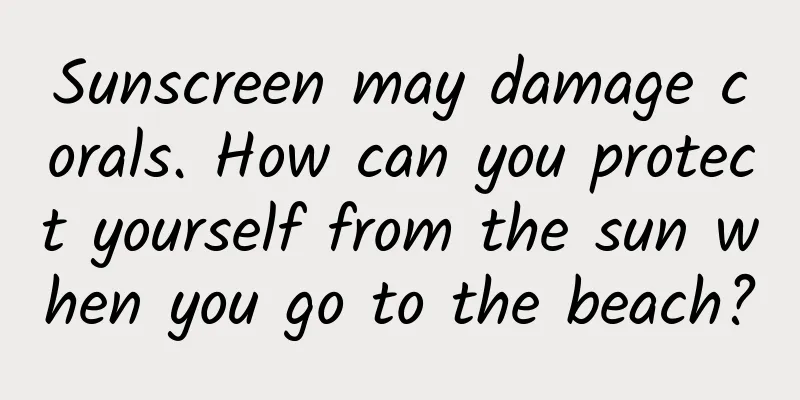Sunscreen may damage corals. How can you protect yourself from the sun when you go to the beach?

|
In 2018, the Republic of Palau restricted the sale and use of sunscreens and skin care products containing 10 different chemicals in order to protect coral reefs. Many people suddenly realized that the chemicals in the sunscreens and skin care products we use daily can actually harm coral reefs! The first summer after the epidemic is coming, and many people are planning to travel to the islands. Will the sunscreen you prepare harm the coral reefs? What sunscreen can you safely bring to the beach? Coral reefs are more than just corals The first thing to make clear is that when we talk about protecting coral reefs, it is not just the coral species that is protected, but the entire complex coral reef ecosystem . More than 4,000 species of fish inhabit coral reefs | Fascinating Universe / Wikimedia Commons Although coral reefs occupy less than 1% of the seafloor, they provide shelter for up to 25% of marine life. Coral reefs are like tropical rainforests on land. Different corals are like tall trees and grass in the rainforest, while colorful tropical fish and small crabs waving their claws are the residents of this underwater forest. When land forests are cut down, the wild animals in the forest will be displaced and hungry; once coral reefs are destroyed, the marine life that shuttles between the corals will also be homeless . Now, this complex and fragile ecosystem is facing an unprecedented crisis. The biggest crisis comes from global warming. When the corals are immersed in abnormally warm seawater for a long time, they will lose their symbiotic algae and become "bleached". This is not just a matter of color. The corals that have lost their algae for a long time will die of hunger and will not be able to regenerate. Bleached coral reef | Acropora / Wikimedia Commons In the current situation of climate change, the area of coral reefs around the world is shrinking year by year , and it is extremely difficult to achieve ecological restoration through natural regeneration; the diversity of marine life such as tropical fish living in coral reefs is also decreasing simultaneously . As large-scale coral bleaching events continue to occur and related research increases, people are beginning to discover that certain chemical ingredients in daily necessities such as sunscreen are unknowingly deepening the damage to the already declining coral reef ecosystem . From a professional perspective, these studies may still have more or less shortcomings; but out of the protection of coral reefs, Palau, an island country located in the western Pacific Ocean that relies on coral reef ecosystems for fisheries and tourism, has issued a "sunscreen ban." Look out for 10 banned ingredients Palau's "sunscreen ban" mainly prohibits sunscreens containing the following 10 ingredients: 10 banned sunscreen ingredients [1] Oxybenzone (Benzophenone-3) Oxybenzone (benzophenone-3) [2] Ethyl paraben [3] Octyl methoxycinnamate (isooctyl methoxycinnamate) Octinoxate (octyl methoxycinnamate) [4] Butyl paraben [5] Octocrylene [6] 4-Methylbenzylidene camphor 4-methyl-benzylidene camphor [7] Benzyl paraben [8] Triclosan [9] Methyl paraben [10] Phenoxyethanol In addition to Palau, the long-established holiday destination of Hawaii also followed suit and announced a similar ban. The US Virgin Islands and the Dutch Caribbean island of Bonaire also began to take action. Palau has 340 islands and numerous coral reefs. | Luka Peternel / Wikimedia Commons These bans target chemical ingredients that are harmful to marine life, and are by no means a blanket ban on all sunscreens ; however, as future research deepens, more ingredients that may also pose a threat to marine life may be added to the ban. These ingredients can absorb ultraviolet rays, have antibacterial and antiseptic effects to a certain extent in sunscreen, but they also affect marine life. Some of these ingredients are ultraviolet absorbers , which absorb ultraviolet rays through photochemistry, but they will be converted into substances that are harmful to marine life ; some enter the seawater and are accumulated in the bodies of marine life, causing harm . For example, oxybenzone can enter coral cells and damage their DNA, preventing them from developing normally. It may also cause coral fertilized eggs to fail to develop normally and kill coral larvae - in other words, it will not only harm existing corals, but will also cause endless harm. Island tourism allows these chemicals to enter the coral reef area|Pixabay Moreover, it is not just sunscreens. The skin care products and cleaning lotions we use daily are also likely to contain these chemicals . They are difficult to be completely removed by modern urban sewage treatment plants and are likely to enter the sea through water circulation. Just like the microplastics that have attracted attention in recent years, studies have shown that these chemical components have been found in various fish around the world. Ultraviolet absorbers are very likely to accumulate through the food chain and produce unexpected long-term effects. Don’t let coral reefs become an underwater “silent spring” Just imagine that when the holidays come, many tourists cover their bodies with sunscreen and enjoy sunbathing in the crowded beaches. However, under the sea, coral reefs are facing unprecedented pressure. In the past tens of millions of years, the natural environment faced by many marine organisms has been more stable. However, in just a few decades or hundreds of years in modern times, they have suddenly had to face such high concentrations of new chemicals that have never appeared in the past , coupled with the large-scale impact of climate change and sea warming, which is adding insult to injury. Coral bleaching on the Great Barrier Reef | Oregon State University We may not be able to assess how much the benefits of banning these chemicals would offset the damage to coral reefs caused by global warming; but we can be sure that this is something that most people can do and that will indeed bring benefits . When choosing sunscreen, try to choose those with the words "marine life friendly", "UV absorber free", "reef-safe", or with the coral protection icon; if you are willing to spend more time on it, you can also compare the ingredients one by one with this list of banned chemicals. The "Ocean Friendly" logo on a certain sunscreen, but most domestic products do not have such a logo yet Of course, in addition to sunscreen, we actually have more options. There are more and more clothing and sun protection products made of sunscreen materials on the market. Physical sun protection is a good choice both in terms of sunscreen effect and reducing skin burden. Just like Silent Spring, in the past we reflected on the harm of chemical pesticides to nature, but now we begin to pay attention to the impact of daily necessities on the environment and reduce our dependence on non-environmentally friendly chemicals. This is more likely to be an opportunity for reflection and self-reflection on how we can use modern science to find or develop products that are safe for the human body, other organisms and the natural environment . Don’t let corals just stay in the present|Toby Hudson / Wikimedia Commons Another summer is coming, and tourism is gradually recovering. While enjoying your trip, don't forget to protect the nature we enjoy now and in the future. Author: Chino Editor: Mai Mai |
<<: Surprise! The rosy strawberries don’t taste sweet at all? The reason is…
Recommend
Bird "hybrids" are rare enough, but how come there are also hermaphroditic birds?
Many readers know that many caged hibiscus bird l...
Automatic warning of risky transactions! WeChat Pay's "anti-fraud customer service reminder" function is launched
On December 14, the WeChat official account annou...
Sword Comes (Fenghuo Xizhuhou) Zongheng Novel_Sword Comes Latest Chapter
Yonghui became Xiangfu, and Xiangfu was changed t...
What should the elderly pay attention to after their test results turn from positive to negative?
Under the epidemic, the elderly are one of the ke...
Who was the ancient human with the largest brain capacity in the Middle Pleistocene? The answer is revealed!
Human brain capacity is closely related to intell...
Interesting stories about scientific discovery: Levitating frog
In 2000, a levitating frog won the Ig Nobel Prize...
How to create a Kuaishou account from scratch? Here’s a how-to guide!
How to create a Kuaishou account from scratch? Af...
No need to go to a massage parlor, daily body aches can be relieved at home by teaching you the correct relaxation techniques!
THE END ▌The theme of the cartoon comes from the ...
Roll up your sleeves and write an Android universal refresh control
In our projects, we often have the need to pull u...
Why does "Laba Garlic" turn into "Miserable Green Boy"? Eating Laba Garlic has so many benefits!
Today is the eighth day of the twelfth lunar mont...
China Automobile Dealers Association: Analysis of the Pickup Truck Market in July 2023
According to the data from the China Passenger Ca...
A brief analysis of mobile Internet advertising fraud methods. How to prevent it?
1. Causes of Cheating Here I would like to first ...
How can an application app avoid becoming a hit and then dying out?
Face Meng has become popular. Whether it is prais...
Alibaba’s Marketing Strategy Transformation from Tmall’s Double Eleven 2018
In the past two days, I have been studying the 20...
6 ways to monetize your products!
The ultimate goal of a product is often to realiz...









